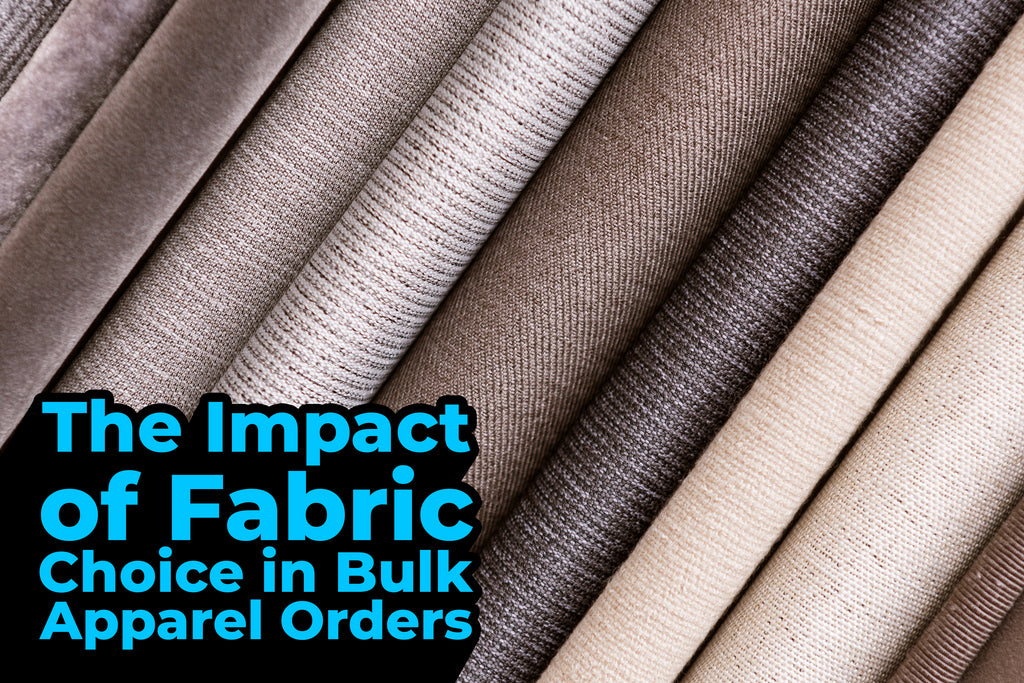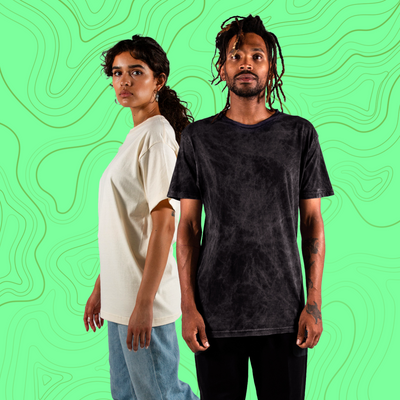The Impact of Fabric Choice in Bulk Apparel Orders
Posted by HAZEL LEYSON

When purchasing bulk apparel, the fabric you choose is one of the most critical decisions you’ll make. Fabric type affects the look, feel, durability, and cost of your products, impacting everything from customer satisfaction to your profit margins. Making the right fabric choice ensures that you deliver quality products that align with your brand’s values, whether you’re selling affordable basics or premium items.
1. Maintaining Product Quality

How Fabric Impacts Comfort and Appearance
Each fabric type has its own characteristics that affect how the clothing feels and looks. For example, cotton is known for its softness and breathability, making it a top choice for everyday wear. Polyester, on the other hand, is lightweight, wrinkle-resistant, and durable, which can be great for activewear or items that need to hold up well with repeated washing.
Think about how you want your products to be perceived by customers. Are you looking to provide ultra-soft, comfortable tees for lounging? Or do you need sturdy fabric that can withstand a lot of activity? Choosing the right material helps you create the ideal experience for your customers and helps keep your brand’s reputation strong.
The Link Between Quality and Brand Reputation
Poor fabric choices can lead to customer dissatisfaction, which may harm your reputation. For instance, if the material is rough, shrinks after the first wash, or fades quickly, customers are unlikely to return for repeat purchases. By investing in high-quality fabrics, you’re building trust with your customers and setting your brand up for long-term success.
2. Optimizing Longevity

Fabric Durability: What to Look For
Certain fabrics are naturally more durable and resistant to wear and tear. For instance, polyester and nylon are both known for their durability and resistance to shrinking and fading. Cotton, while soft and comfortable, may shrink if not properly treated. Blends, like a cotton-polyester mix, combine the best of both worlds, offering the softness of cotton with the durability of polyester.
When buying bulk apparel, it’s worth considering the longevity of each fabric. Apparel that lasts not only reduces returns and replacements but also enhances customer loyalty—when customers know your products are reliable, they’re more likely to keep coming back.
Reducing Returns Through Longevity
A high rate of returns can be a costly headache, especially if it’s due to poor fabric choice. If the fabric wears out quickly or loses shape after washing, you may see an increase in returns, cutting into your profit margins. Selecting durable fabrics from the start helps you avoid these issues, leading to happier customers and more consistent profits.
3. Managing Pricing and Profit Margins

Balancing Cost and Quality
Higher-quality fabrics often come with a higher price tag, but they can also enhance the perceived value of your products, allowing you to charge more. For example, natural fibers like organic cotton or merino wool are generally more expensive than synthetic options, but they’re also associated with luxury and quality.
On the other hand, synthetic fabrics like polyester are typically more affordable and offer great durability, which can be an advantage for brands looking to provide affordable apparel without compromising longevity. Finding a balance between fabric cost and quality can help you keep prices competitive while protecting your profit margins.
How Fabric Choice Affects Pricing Strategy
Knowing the cost per unit of different fabrics allows you to adjust your pricing strategy. If you’re using premium fabrics, you may want to position your brand as a premium option, focusing on high-quality materials that justify a higher price. Conversely, if you opt for cost-effective fabrics that still offer durability, you can appeal to customers looking for affordable yet reliable apparel.
By choosing fabrics that align with your brand’s pricing strategy, you’ll be able to maximize profits while keeping your customers satisfied with products that meet their expectations.
Making the Right Choice for Your Brand
Choosing the right fabric isn’t just about picking what’s popular—it’s about selecting materials that reflect your brand’s values and appeal to your target audience. Here’s a simple guide to help you make the best choice for your business:
- Identify Your Brand’s Priorities: Are you focusing on luxury, affordability, sustainability, or durability? Knowing your brand’s priorities helps you narrow down fabric options.
- Consider Your Target Market: Who is buying your products, and what are they looking for? Activewear customers, for example, may prioritize breathability and flexibility, while customers purchasing basics might care more about comfort and softness.
- Balance Cost and Quality: Find fabrics that meet your quality standards while fitting within your budget. Blends, for example, offer a nice balance between cost and performance, allowing you to meet customer expectations without overspending.
By aligning your fabric choices with your brand’s goals and customer needs, you ensure that each bulk order supports your business strategy and builds brand loyalty.
Conclusion: Choose Fabrics That Support Your Business Goals
Fabric choice is a crucial factor in bulk apparel that influences everything from product quality to customer satisfaction and profit margins. When you select fabrics that prioritize comfort, durability, and cost-effectiveness, you’re setting up your business for success. You’ll deliver products that not only meet customer expectations but also enhance your brand’s reputation.
At VS Tees, we understand the impact of fabric choice on your business’s success. With our high-quality materials and options that cater to different business goals, we help you make the most of your bulk apparel orders. Ready to find the perfect fabric for your brand? Let’s talk!





